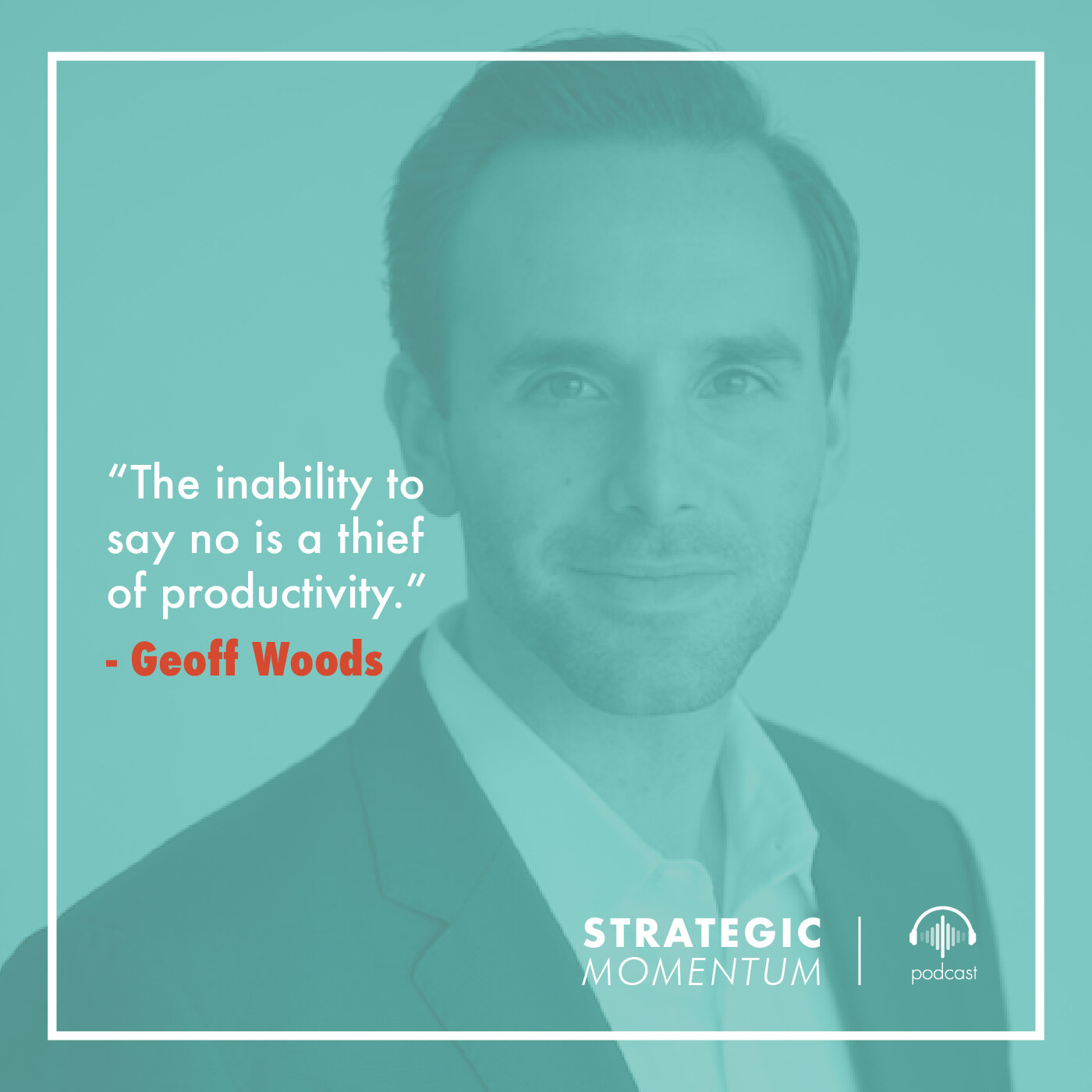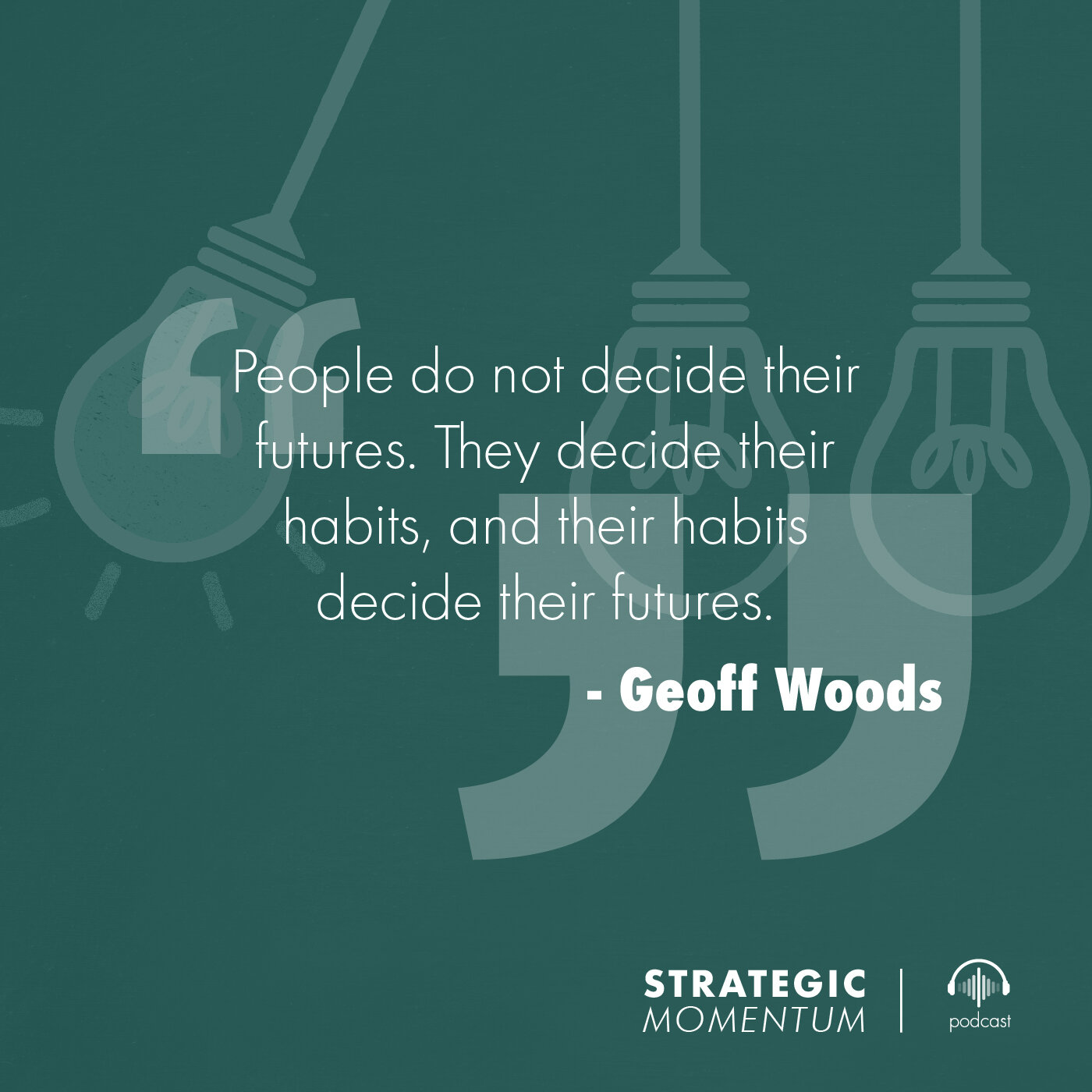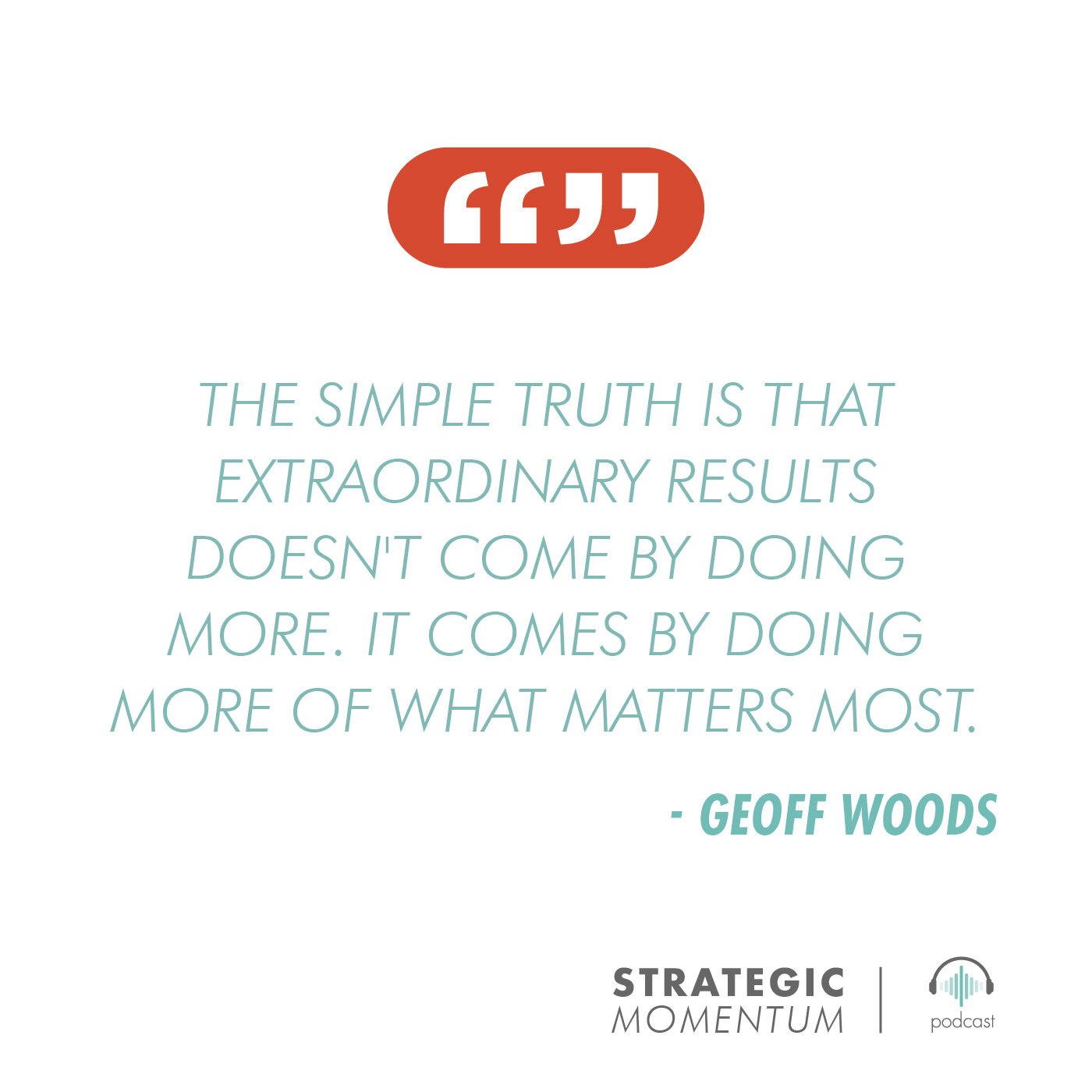Ep. 57 - Productivity And Time Management: How To Prioritize What Matters Most To Drive Extraordinary Results - With Geoff Woods
Find Us Wherever You Listen To Podcasts
With growing demands on our time, being able to manage it all professionally and personally is a universal challenge. It is not always easy to create focus and clarity that will drive positive momentum for you and your company. Many of us succumb to lies of productivity, rather than implementing an effective goal-setting process.
So what does it take to create the focus necessary to drive positive momentum for you, your company, and your career?
Geoff Woods is Vice President of The ONE Thing, the training company that teaches people how to live a life of focus so that they have more by doing less, based on the top-rated business book of the same name by billionaire Gary Keller and his NY Times best selling co-author Jay Papasan.
In this episode you will learn:
The importance of clarity, control and community around your target goals
The lies of productivity and the common daily work habits that get us stuck when it comes to time management
The valuable goal-setting processes that leads to doing more of what matters most.
Defining his Goals, Looking to Give, and Surrounding Himself with People That Were Where He Wanted to Be
Geoff’s journey to The ONE Thing began when two life events caused him to disrupt his medical device sales career and life perspective: An unexpected stroke of a close colleague at the early age of 35, coupled with a change in his company’s commission structure that reduced his income by 40% overnight.
All of this caused him to re-examine his values and, ultimately, his goals personally and professionally. And at that time, he heard the popular Jim Rohn quote, “You are the average of the five people you spend the most time with.” Geoff considered his five and realized that he needed to surround himself with those who were more ideally aligned to where he wanted to be career-wise. That aspiration wasn’t continuing to climb the ladder in his existing profession, but rather it was a desire to pivot into real estate investing.
This clarity of vision (and the ability to directly convey what he was looking for) led him to focus on networking and learning from successful commercial real estate investors. And as he started his journey, he met a successful investor who took him under his wing. Through that experience and other relationships he built along the way, he learned a fundamental lesson:
“When I started surrounding myself with people who [were] where I wanted to be, I noticed that they didn't show up in the room looking to get. They showed up looking to give. The most successful people weren't looking over your shoulder when they were talking to you to see if there was somebody better they should be talking to, they were genuinely present. And in the back of their mind, they were actually wondering how they could support you.”
And applying this mindset on the fateful day he met The ONE Thing co-author Jay Papasan is was what led him to where he is today.
Prioritizing The ONE Thing
The premise behind The ONE Thing is based off one simple truth; achieving extraordinary results doesn't come by doing more, but by doing more of what matters most. And one of the core models is the 80/20 rule — 80% of your results come from 20% of your actions.
Geoff indicates it’s this lack of clarity, control, and community that inhibits people and the organizations they work for from understanding the right questions to ask to get to those prioritized goals.
Leaders may think they're being clear on what their priority is, but often times this is not the case from an employee’s perspective, which creates uncertainty in their roles and end goals. And if priorities do change, employees aren’t sure what to do as a result.
And when there isn’t clarity on priorities, alignment can’t be achieved, leading to a lack of control. That in turn creates a lack of community because there is no common language that can help drive people towards the completion of these goals.
What Gets in the Way and The Lies of Productivity
What commonly gets us stuck in determining those priorities, and subsequently managing time against these, is treating every objective or task such that they matter equally. Further, the common habit of defining goals and subsequent priorities through ‘to-do’ lists (and striving to complete all the tasks in a set time) places a false value on each task.
Another factor that can prevent many from making progress against their most important priorities is taking the approach of ‘what is the best I can do’ vs. this notion of ‘what’s the best that can be done.’ Viewing your actions/activities within your own silo vs. the actions that can positively impact the organization as a whole limits your ability to “move from being entrepreneurial to being purposeful.”
Further, effectively managing your time and minimizing the distractions that often get in the way are challenges that inhibit positive movement. And Geoff tells us it is our “inability to say no that is the thief of productivity.”
Breaking through Inertia
Creating the necessary traction around what matters most starts by thinking big and then going small. That involves working toward a singular goal, identifying a few priorities that support that goal, and then defining corresponding activities (five for each in The ONE Thing’s GPS Plan model) that will help you make progress towards completing that goal.
This clarity on your priorities will lead to control of your time and establish a common language — all to create alignment and a sense of community so everyone in the organization wins together.
And for Geoff, these practices are those that can, and should be, applied to one’s personal life, as he believes personal and professional fulfillment are intrinsically linked.
When you and your company create habits of thinking and doing in priority, this decides your future — and that future is where you will be able to ensure your time is managed wisely to achieve the momentum you are looking for; to achieve your legacy.
Geoff’s Career Advice
As a leader, you have to care as much about people’s personal lives as their professional lives
Standards without consequences are merely suggestions. If actions don’t bring consequences, then these standards have not been communicated correctly.
People do not decide their futures. They decide their habits, and their habits decide their futures
Look into the future at something that you want and ask, ‘Who’s the person I can become, and what’s the habit I can form, that would make that future possible?’
Key Takeaways:
Employ the 80/20 rule to drive focus on those priorities and activities that will have the greatest impact vs. taking the approach that everything matters equally.
It’s not the volume of tasks completed (aka checking off your to-do list) but rather working on those activities that have the greatest impact on your most important goals.
Think Big and Act Small. Map out the hierarchy of priorities and activities from the strategic vision all the way down to the tactical day-to-day tasks.
Challenge yourself and your team to ask those important questions that will help you rank what truly will move the needle.
And make sure to assign who will own those key priorities/strategies and dictate when they need to be done to ensure accountability.
Create this habit of thinking in order of priority — Think of one big goal first and then the few major priorities (those 20 percenters) that will have the most impact towards achieving it.
This approach can be done on a day-to-day basis against both your personal and professional goals to create a sustainable habit.
Establish this framework (essentially a one-page business plan) in order to facilitate a common vision that will drive clarity and alignment, as well as providing a common language for everyone from the top down in an organization.
Goals and priorities across the business become fully transparent. Employees see their place in it and a structure of ownership and focus can be put in place.
This changes the approach from doing the best that an individual can do to doing the best that can be done for everyone. Each person’s work now has more value and purpose leading to a team mentality that will drive the greatest impact.
Driving alignment through this common vision will give you and your employees a sense of control so they feel they can manage their workload, as well as a community to help them reach their goals.
When everybody knows what their one thing is, and they have a common language to communicate with one another, you build a sense of community.
Effective time management requires you to minimize distractions and focus on your critical priorities through more effective time blocking.
Make it a point of doing it for yourself proactively vs. it being a reactive activity once you see what free time remains.
Focus your time block on what can you do to accomplish your priorities vs. just checking off the list of tasks.
After you block off time to work on a task, don’t violate it. It is crucial to protect this time in order to continue to create traction against Your ONE Thing.
As a leader, driving greater retention and productivity from your employees requires you to understand the whole person.
Recognize that their personal goals are as important as their professional goals
Consider that individual’s entire ecosystem influences their ability to accomplish their goals for you or themselves.
Decide who you want to become and identify the habits needed to make that future a reality.
Align personal and professional goals, and block off time for your life outside of work to ensure you are in the best position to prosper in your career and at home.
Resources:
Connect with Geoff: Twitter
Find us on Social Media:
FACEBOOK: Strategic Momentum Podcast
INSTAGRAM: @strategicmomentum
TWITTER: @flywheelassoc
LINKEDIN: Flywheel Associates
YOUTUBE: Flywheel Associates
PINTEREST: Flywheel Associates
Subscribe to the Strategic Momentum podcast:











